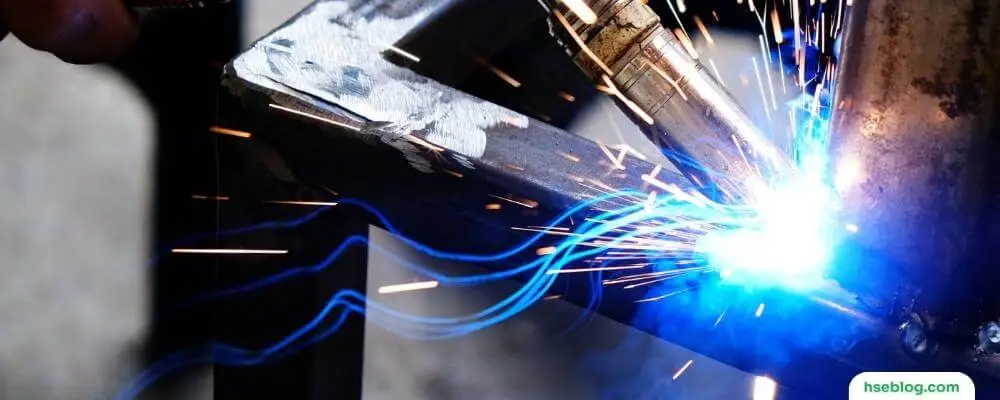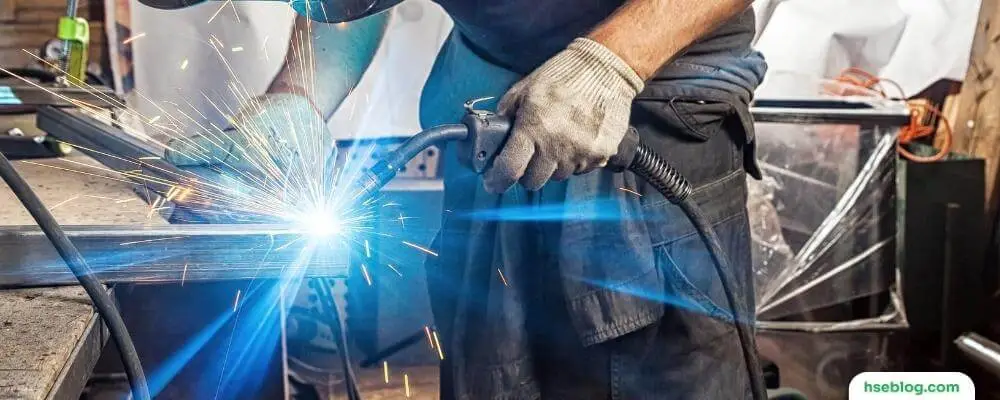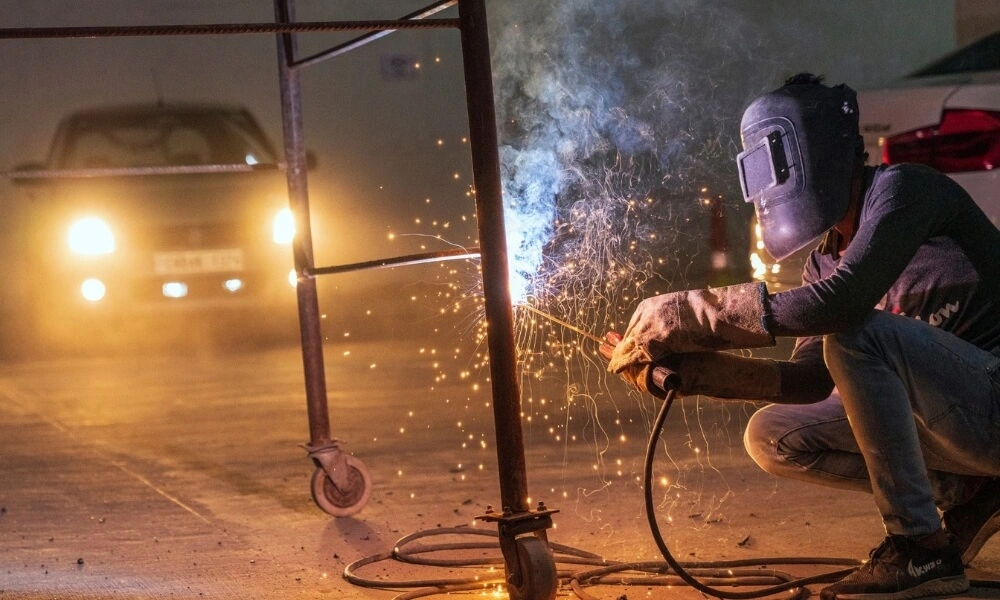Welding is an integral process in industries ranging from construction and manufacturing to automotive repair and metal fabrication. Among the various techniques available, gas and electric arc welding are the most widely used methods. However, with the numerous advantages that these welding processes bring, they also come with their fair share of hazards that can be detrimental to the health and safety of welders and those nearby.
Whether you are a seasoned welding professional, a beginner, or someone involved in overseeing welding operations, being well-informed about the potential hazards and the necessary control measures is indispensable.
In this comprehensive blog post, we will delve into the key components and equipment involved in gas and electric arc welding, explore the hazards associated with each method, and discuss the essential control measures that can be adopted to ensure a safe and productive welding environment. From handling volatile gases to protecting oneself from radiation exposure, understanding these safety aspects is vital and life-saving.
Gas Welding Hazards & Control Measures
Gas welding, frequently employed in maintenance work, brazing, and soldering for its slow speed and ease of control, present certain hazards. Understanding these risks and taking the appropriate safety measures is crucial.
Equipment involved in gas welding includes cylinders of acetylene and oxygen, regulators, hoses, a welding torch with tips, a cutting attachment or a separate torch, a friction igniter, wrenches, goggles, gloves, and flame-resistant clothing when required.
The Key Components
- Acetylene: Acetylene (C2H2), a fuel gas comprised of carbon and hydrogen, creates a high-temperature flame (5700°F to 6300°F) when burned with oxygen. Acetylene gas is odoriferous and colorless.
- MAPP Gas: MAPP (methylacetylene-propadiene) gas combines the high flame temperature of acetylene and the handling properties of propane. It’s stable and won’t combust without oxygen, and it’s safe to store and transport under varying conditions. However, high concentrations may induce anesthetic effects, and contact with liquid MAPP gas can result in severe frostbite-like injuries due to its storage temperature.
- Oxygen: Oxygen is an odorless, colorless, tasteless gas that supports combustion but does not burn independently. It can become highly explosive when mixed with other gases, particularly if contaminated with hydrogen or hydrocarbons. Contact with oil or grease should be strictly avoided.

Hazards and Control Measures
Gas welding can be hazardous if proper safety precautions are not taken. Here are some common hazards associated with gas welding and control measures to mitigate them:
- Gas Explosion: Gas welding can pose an explosion risk if gases are improperly mixed or if the oxygen supply is contaminated. This hazard can be controlled by carefully handling and storing gases and ensuring the equipment is clean and free from oil or grease.
- Burns: The high temperatures associated with gas welding can cause severe burns. Safety measures include wearing flame-resistant clothing, gloves, and protective eyewear.
- Inhalation Hazards: Inhaling gases or fumes from welding can have adverse health effects. Proper ventilation or respiratory protective equipment should be utilized to control this risk.
- Eye Damage: Welding can cause damage to the eyes due to intense light and potential splatter. Eye protection, such as safety goggles with filter lenses, should always be worn during welding operations.
- Physical Injuries: Improper handling of heavy equipment and cylinders can lead to physical injuries. Proper lifting techniques and maintaining a tidy workspace can help minimize this risk.
- Fire Hazards: The extremely hot flame produced during welding can ignite flammable or combustible materials in the vicinity. As a control measure, ensure the welding area is free from such materials. Also, have appropriate fire extinguishing equipment readily available.
- Gas Leaks: Leaks from hoses, cylinders, or connections can lead to gas buildup, potentially causing an explosion. Regularly check all equipment for leaks and repair or replace them as necessary.
- UV Radiation: The welding process produces ultraviolet (UV) radiation, which can cause burns to exposed skin and eyes. Welders should always use appropriate PPE, including welding helmets with the correct filter lens and protective clothing covering all skin.
- Acoustic Trauma: The noise levels produced during gas welding can lead to hearing damage over time. Use hearing protection devices such as earmuffs or earplugs to reduce this risk.
- Cylinder Explosion: Improper handling or storage of gas cylinders can cause them to explode. Cylinders should be handled gently, stored upright in well-ventilated areas away from heat sources, and chained or clamped to prevent falling or tipping.
- Musculoskeletal Disorders: Long-term repetitive movements or awkward positions while welding can lead to musculoskeletal disorders. Encourage frequent breaks, proper ergonomics, and potentially use supports or stands to hold heavy equipment.
- Tripping Hazards: Cables, hoses, and other equipment on the workshop floor can pose tripping hazards. Maintain a clean and organized workspace to reduce the risk of accidents.
- Confined Space Hazards: When welding in confined spaces, there can be risks of gas accumulation, lack of oxygen, and difficulty escaping in case of an emergency. Never weld in a confined space without proper training, appropriate ventilation, and an emergency escape plan.
- Chemical Hazards: Welding can produce harmful fumes and irritate the skin if inhaled. Use local exhaust ventilation to remove fumes at the source, and always wear appropriate PPE.
Remember, safety should always be the top priority in any welding operation. Training, personal protective equipment, regular equipment maintenance, and adherence to safety guidelines can significantly minimize these hazards.

Electric Arc Welding Hazards and Control Measures
Electric arc welding is a widely used method for joining metals. However, it comes with various hazards that can cause injuries if safety measures are not in place. Here, we’ll delve into these hazards and explain the measures that can be employed to mitigate them.
- Radiation Exposure: Electric arc welding produces ultraviolet (UV) and infrared (IR) radiation, which can cause harm to the eyes and skin. Unprotected exposure can lead to burns similar to sunburns and eye damage. Welders should wear helmets or face shields with lenses to protect against UV and IR radiation. Moreover, clothing that covers the skin, such as gloves, jackets, and long-sleeve shirts, can minimize exposure to harmful radiation.
- Arc Flash: An arc flash occurs when a bright light is emitted from the welding arc, which can temporarily blind individuals or cause damage to the retina with prolonged exposure. To mitigate the risks associated with arc flash, it is essential to shield the welding area so that individuals cannot inadvertently look directly at the arc. In cases of severe exposure, immediate medical attention should be sought.
- Electric Shock: Welders risk electric shock due to the electrical currents involved in arc welding, especially in wet or damp conditions. Welders should use insulated electrode holders and wear dry gloves to prevent electric shock. Moreover, arc welding should ideally be performed in dry environments, and if in wet conditions, extra precautions such as insulated platforms should be used.
- Flying Sparks and Molten Metal: The welding process can produce flying sparks and molten metal, which can cause burns or ignite flammable materials. Wearing heavy-duty clothing without cuffs, ensuring that pockets are covered, and removing flammable items from the vicinity is essential. Additionally, wearing high-top boots with steel toes can provide extra protection against falling molten metal.
- Hot Metal and Burns: Handling hot metal or being exposed to flying sparks can result in severe burns. It’s imperative never to handle hot metal without protection. Leather gloves and protective gear should be worn, including jackets, leggings, aprons, and hats. In the case of gas welding, flame-resistant clothing and hair protection are necessary due to the high temperatures involved.
- Gases and Fumes: Welding can produce harmful fumes and gases, irritating the respiratory system and posing long-term health risks. Welding should be conducted in well-ventilated areas to minimize inhalation of fumes. Additionally, wearing safety goggles and using respirators when necessary can provide protection. It’s also vital to be knowledgeable about the materials being welded, the possible fumes they can produce, and to take appropriate precautions.
- Noise and Vibrations: The arc welding process can generate high levels of noise and vibrations, which can cause hearing damage and hand-arm vibration syndrome over time. Welders should wear ear protection such as earplugs or earmuffs to reduce noise exposure. For vibrations, using anti-vibration gloves and taking regular breaks can help reduce the risk of developing hand-arm vibration syndrome.
- Musculoskeletal Disorders: Welders often work in awkward positions for extended periods, leading to musculoskeletal disorders such as back pain or repetitive strain injuries. Ergonomic workstations should be designed to minimize awkward postures. Welders should also be trained in proper lifting techniques, and regular breaks should be encouraged to prevent overexertion.
- Fire and Explosions: The sparks and heat generated by welding can ignite flammable materials and cause fires or explosions, especially if welding is done near flammable liquids or gases. Ensure that the welding area is free of any flammable materials. Keep fire extinguishers and other firefighting equipment nearby. In cases where welding must be performed near flammable materials, a fire watch should be maintained.
- Eye Fatigue: Continuous focus on welding can lead to eye fatigue, affecting performance and safety. Welders should take regular short breaks to rest their eyes. Proper lighting in the workspace can also reduce eye strain. Anti-glare screens can be used where applicable.
- Exposure to Ultraviolet (UV) Light: In addition to the radiation emitted from the arc, welders are also exposed to UV light, which can cause “welder’s flash” or photokeratitis. Welders should wear welding helmets with proper shading to protect their eyes from UV light. They should also wear clothing that covers as much skin as possible and use screens to shield others from UV light.
- Slips, Trips, and Falls: Welding environments often have cables, tools, and other equipment that can create tripping hazards. Additionally, oil or other substances can make surfaces slippery. Keep the workspace organized and clear of unnecessary equipment or debris. Use cable covers or organizers to keep cables from lying across walkways. Ensure the flooring is in good condition and free from oil or other substances that can cause slips.
- Toxic Metal Exposure: Welding certain metals, such as galvanized steel, can produce highly toxic fumes (e.g., zinc fumes). Be aware of the metals being welded and the potential for toxic fume production. Use appropriate ventilation and respiratory protection when welding metals that produce hazardous fumes. Follow recommended guidelines for exposure limits.
- Stress and Fatigue: The physical demands and concentration required in welding can lead to stress and fatigue. Ensure a balanced workload and encourage regular breaks. Provide a supportive work environment and, if possible, rotate tasks among workers to reduce mental fatigue.
By recognizing these additional hazards and implementing the appropriate control measures, welding can be done more safely and efficiently, protecting the well-being of welders and those around them.
Conclusion
In conclusion, while invaluable in various industries, gas and electric arc welding comes with various hazards, including fire, explosions, exposure to harmful radiation, and physical injuries. Individuals involved in welding must prioritize safety by comprehending the risks and rigorously implementing control measures such as using personal protective equipment, ensuring proper ventilation, regular equipment maintenance, and adhering to safety protocols. Through vigilance, education, and the adoption of best practices, welding operations can be performed effectively while safeguarding the health and well-being of all involved.

